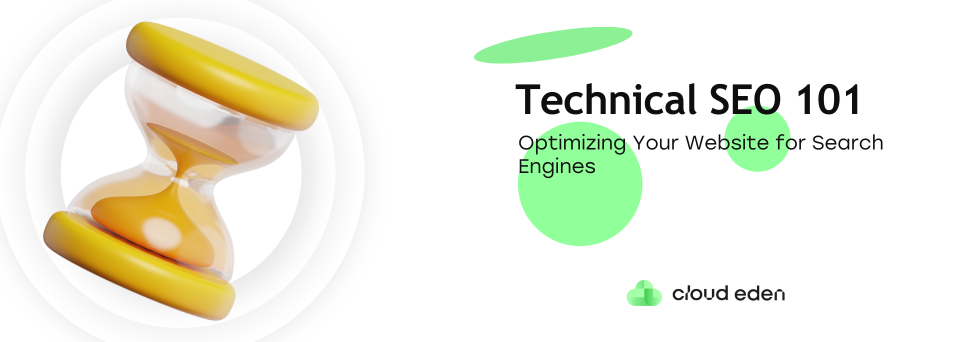Technical SEO 101: Optimizing Your Website for Search Engines
This is a subtitle for your new post

Table of Contents
- Introduction
- Understanding Technical SEO
2. Key Elements of Technical SEO
- Crawlability and Indexability
- Site Architecture
- Website Speed and Performance
- Secure Sockets Layer (SSL)
- Structured Data Markup
3. Detailed Explorations and Analyses
- Crawlability and Indexability: Best Practices
- Site Architecture: Creating an SEO-Friendly Structure
- Website Speed and Performance: Techniques for Improvement
- SSL Implementation: Enhancing Security and SEO
- Structured Data Markup: Leveraging Schema for Enhanced Listings
4. Advanced Technical SEO Strategies
- Log File Analysis
- International SEO
- JavaScript SEO
- Core Web Vitals
5. Conclusion
6. Additional Resources
- Google Search Console
- Google PageSpeed Insights
- Google Structured Data Markup Helper
In digital marketing, staying ahead of the competition means understanding and implementing the latest SEO strategies. Technical SEO is a crucial aspect of this, focusing on the backend of your website to ensure it's optimized for search engines. This guide will explore the key elements of technical SEO, offering detailed insights and analyses to help you establish authority and expertise in this field.
Understanding Technical SEO
Technical SEO involves optimizing your website's infrastructure to facilitate search engine crawling and indexing. It differs from on-page SEO, which focuses on content, and off-page SEO, which deals with backlinks and social signals. Technical SEO ensures that your site meets the technical requirements of search engines, leading to improved organic rankings.
Key Elements of Technical SEO
- Crawlability and Indexability
- Crawlability: This refers to the search engine's ability to access and crawl your website's pages. Ensuring that your site's structure is logical and your URLs are accessible is crucial. Use tools like Google Search Console to identify and fix crawl errors.
- Indexability: Once crawled, a page must be indexed to appear in search results. Ensure that important pages are indexable by using proper meta tags and avoiding noindex directives on critical pages.
2. Site Architecture
- URL Structure: A clean and logical URL structure helps search engines understand the hierarchy of your site. Use descriptive keywords in your URLs and avoid using special characters.
- Sitemaps: An XML sitemap acts as a roadmap for search engines, guiding them to all the important pages on your site. Regularly update your sitemap and submit it to Google Search Console.
3. Website Speed and Performance
- Page Load Time: Fast-loading pages improve user experience and are favored by search engines. Use tools like Google PageSpeed Insights to analyze and improve your site's speed.
- Mobile Optimization: With the increasing use of mobile devices, ensuring that your site is mobile-friendly is essential. Implement responsive design techniques to provide a seamless experience across all devices.
4. Secure Sockets Layer (SSL)
- HTTPS: Securing your site with an SSL certificate is not only important for protecting user data but also for SEO. Google considers HTTPS a ranking factor, so ensure your site is secure.
5. Structured Data Markup
- Schema Markup: Implementing structured data using schema markup helps search engines understand the content of your pages better. This can enhance your search listings with rich snippets, providing more information to users directly in the search results.
Detailed Explorations and Analyses
Crawlability and Indexability: Best Practices
Ensuring that your site is crawlable and indexable is foundational to technical SEO. Here are some best practices:
- Robots.txt File: This file instructs search engine bots on which pages to crawl and which to ignore. Properly configuring your robots.txt file can prevent search engines from wasting time on irrelevant pages.
- Canonical Tags: Use canonical tags to avoid duplicate content issues. These tags signal to search engines which version of a page is the master copy, consolidating ranking signals to the preferred URL.
- Fixing Crawl Errors: Regularly check Google Search Console for crawl errors and fix them promptly. This might involve redirecting broken links, updating sitemaps, or fixing server errors.
Site Architecture: Creating an SEO-Friendly Structure
A well-structured site enhances both user experience and search engine understanding:
- Hierarchy and Navigation: Organize your site into a clear hierarchy with main categories and subcategories. This structure should be reflected in your navigation menu and breadcrumbs.
- Internal Linking: Use internal links to connect related content. This not only helps users navigate your site but also distributes link equity across your pages, helping them rank better.
- URL Best Practices: Keep URLs short, descriptive, and keyword-rich. Avoid using numbers, special characters, or case sensitivity in URLs, as these can complicate crawling and indexing.
Website Speed and Performance: Techniques for Improvement
Optimizing your site's speed and performance is crucial for both user experience and SEO:
- Minify CSS, JavaScript, and HTML: Reduce the size of your code files by removing unnecessary characters, comments, and spaces. This can significantly decrease load times.
- Optimize Images: Use compressed image formats like WebP and implement lazy loading to ensure images load only when they appear in the viewport.
- Leverage Browser Caching: Set up browser caching to store static resources on users' devices, reducing load times for repeat visitors.
SSL Implementation: Enhancing Security and SEO
SSL certificates are essential for securing user data and improving SEO:
- Choosing an SSL Certificate: Select the right type of SSL certificate for your site, whether it's a single domain, multi-domain, or wildcard certificate.
- Implementing HTTPS: Ensure all pages on your site are served over HTTPS. Update internal links, canonical tags, and sitemaps to reflect the new HTTPS URLs.
- Mixed Content Issues: After migrating to HTTPS, ensure that all resources (images, scripts, stylesheets) are also served over HTTPS to avoid mixed content warnings.
Structured Data Markup: Leveraging Schema for Enhanced Listings
Structured data markup can significantly enhance your search engine listings:
- Types of Schema Markup: Identify the most relevant schema types for your content, such as articles, products, events, and reviews.
- Implementing Schema: Use JSON-LD format to add schema markup to your pages. Tools like Google's Structured Data Markup Helper can assist in generating the necessary code.
- Testing and Monitoring: Regularly test your structured data using Google's Rich Results Test to ensure it's correctly implemented and yielding the desired rich snippets.
Advanced Technical SEO Strategies
To stay ahead in the competitive landscape, consider these advanced strategies:
- Log File Analysis
- Understanding Bot Behavior: Analyzing server logs can provide insights into how search engine bots are crawling your site. Identify patterns, bottlenecks, and areas that need improvement.
- Improving Crawl Efficiency: Use log file analysis to prioritize important pages and ensure they are crawled more frequently. This can be particularly useful for large websites with thousands of pages.
2. International SEO
- Hreflang Tags: Implement hreflang tags to signal the language and regional targeting of your pages. This helps search engines serve the correct version of your site to users based on their location and language preference.
- Geo-Targeting: Use tools like Google Search Console to set geographic targets for your website. This is especially important for businesses operating in multiple countries.
3. JavaScript SEO
- Handling JavaScript Content: Ensure that search engines can crawl and index your JavaScript content. Use tools like Google Search Console's URL Inspection tool to check how your pages are rendered.
- Progressive Enhancement: Implement progressive enhancement to ensure that your site functions well without JavaScript. This can improve accessibility and SEO.
4. Core Web Vitals
- User Experience Metrics: Focus on Core Web Vitals, which include Largest Contentful Paint (LCP), First Input Delay (FID), and Cumulative Layout Shift (CLS). These metrics are critical for evaluating user experience and are considered ranking factors by Google.
- Improving Metrics: Optimize your site's performance to improve these metrics. This might involve optimizing server response times, minimizing render-blocking resources, and ensuring visual stability.
Conclusion
Technical SEO is an essential component of a comprehensive SEO strategy. By focusing on crawlability, site architecture, speed, security, and structured data, you can enhance your site's visibility and performance in search engine results. Advanced strategies like log file analysis, international SEO, JavaScript SEO, and Core Web Vitals further refine your approach, ensuring you stay ahead of the competition. Implement these techniques to optimize your website for search engines and provide a seamless, user-friendly experience.
Additional Resources
- Google Search Console: A free tool that helps you monitor and maintain your site's presence in Google Search results.
- Google PageSpeed Insights: A tool for analyzing and optimizing your site's speed.
- Google Structured Data Markup Helper: Assists in creating structured data markup for your site.
By following these guidelines and staying updated with the latest SEO trends, you can ensure your website is well-optimized for search engines, driving more organic traffic and achieving higher rankings.
Welcome To Our Blog





